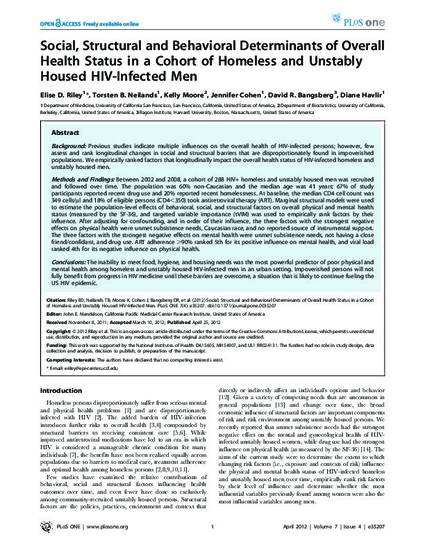
- AIDS (Disease) -- Social aspects,
- HIV infections -- Social aspects,
- HIV infections,
- Homeless men -- California -- San Francisco -- Health and hygeine,
- HIV infections -- Treatment
Background: Previous studies indicate multiple influences on the overall health of HIV-infected persons; however, few assess and rank longitudinal changes in social and structural barriers that are disproportionately found in impoverished populations. We empirically ranked factors that longitudinally impact the overall health status of HIV-infected homeless and unstably housed men.
Methods and Findings: Between 2002 and 2008, a cohort of 288 HIV+ homeless and unstably housed men was recruited and followed over time. The population was 60% non-Caucasian and the median age was 41 years; 67% of study participants reported recent drug use and 20% reported recent homelessness. At baseline, the median CD4 cell count was 349 cells/ml and 18% of eligible persons (CD4,350) took antiretroviral therapy (ART). Marginal structural models were used to estimate the population-level effects of behavioral, social, and structural factors on overall physical and mental health status (measured by the SF-36), and targeted variable importance (tVIM) was used to empirically rank factors by their influence. After adjusting for confounding, and in order of their influence, the three factors with the strongest negative effects on physical health were unmet subsistence needs, Caucasian race, and no reported source of instrumental support. The three factors with the strongest negative effects on mental health were unmet subsistence needs, not having a close friend/confidant, and drug use. ART adherence .90% ranked 5th for its positive influence on mental health, and viral load ranked 4th for its negative influence on physical health.
Conclusions: The inability to meet food, hygiene, and housing needs was the most powerful predictor of poor physical and mental health among homeless and unstably housed HIV-infected men in an urban setting. Impoverished persons will not fully benefit from progress in HIV medicine until these barriers are overcome, a situation that is likely to continue fueling the US HIV epidemic.nstitute, Harvard University.
Note: At the time of writing, David Bangsberg was affiliated with the Ragon Institute, Harvard University.
Copyright: 2012 Riley et al.